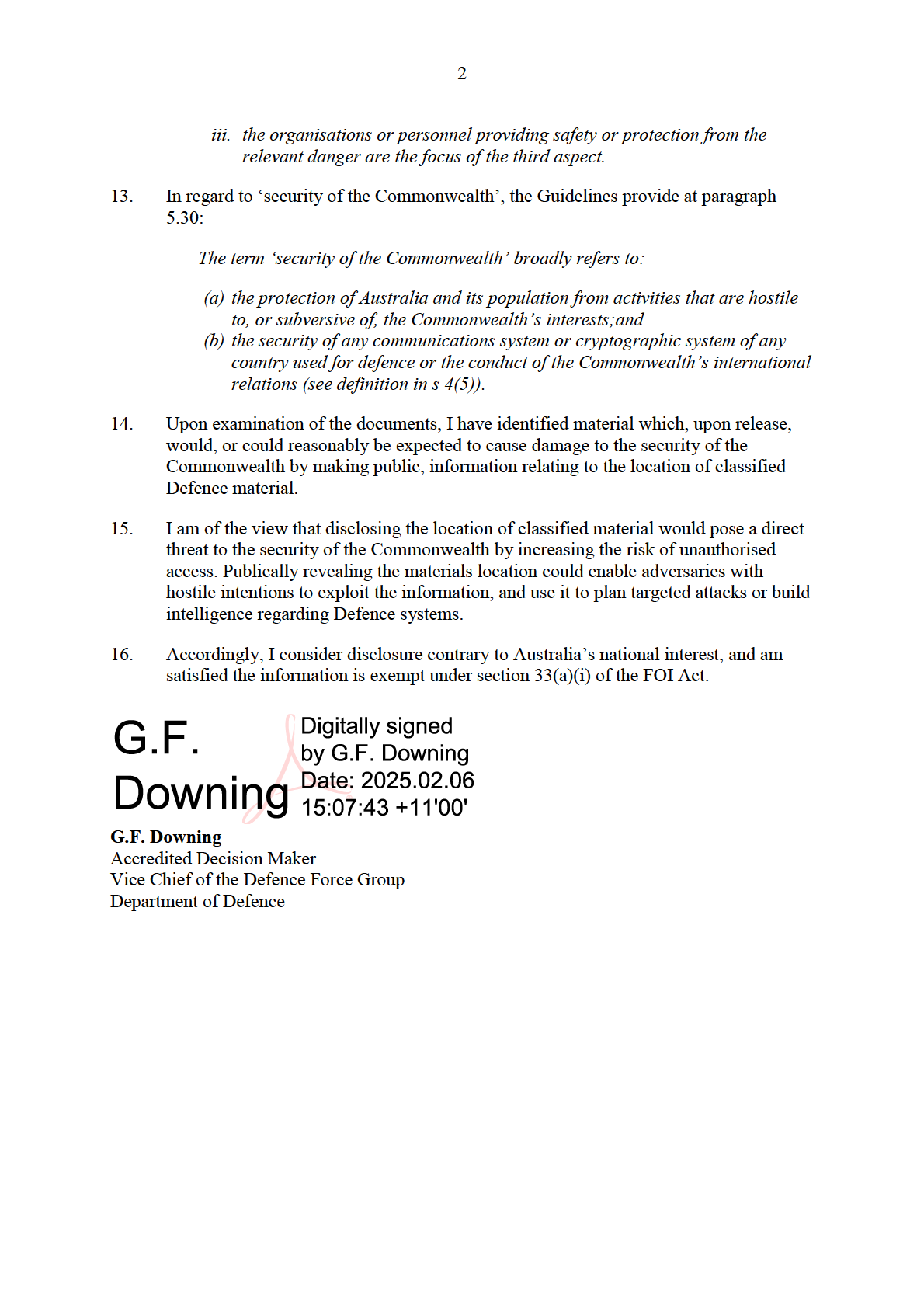
DEFENCE FOI 467/24/25
STATEMENT OF REASONS UNDER THE FREEDOM OF INFORMATION ACT 1982
1.
I refer to the request by John Davis (the applicant), dated and received on
12 December 2024 by the Department of Defence (Defence), for access to the
following documents under the Freedom of Information Act 1982 (Cth) (FOI Act):
I am seeking the ADF Joint Doctrine Hierarchy Chart as a PDF Document. This
should be something similar to what the US Department of Defence has made
available via their website where they outline where different parts of their Joint
Doctrine fits within the various types of Doctrine such as either Capstone,
Philosophical, Integration or Application, type of Doctrine, as described per this link
here - https://www.acmc.gov.au/defence-doctrine-documents
Background
2.
On 18 December 2024, with the applicant’s written agreement Defence extended the
period for dealing with the request from 11 January 2025 until 10 February 2025 in
accordance with section 15AA [extension of time with agreement] of the FOI Act.
FOI decision maker
3.
I am the authorised officer pursuant to section 23 of the FOI Act to make a decision on
this FOI request.
Documents identified
4.
I have identified two documents as falling within the scope of the request.
Exclusions
5.
Duplicates of documents, and documents sent to or from the applicant are excluded
from this request. Defence has only considered final versions of documents.
Decision
6.
I have decided to:
a. release one document in full; and
b. partially release one document in accordance with section 22 [access to edited
copies with exempt or irrelevant matter deleted] of the FOI Act on the grounds
that the deleted material is considered exempt under section 33(a) [Documents
affecting national security, defence or international relations] of the FOI Act.
Material taken into account
7.
In making my decision, I have had regard to:
c. the terms of the request;
d. the content of the identified documents in issue;
2
e. relevant provisions of the FOI Act;
f. the Guidelines published by the Office of the Australian Information
Commissioner under section 93A of the FOI Act (the Guidelines); and
g. discussions with Director ADF Doctrine, ADF HQ.
REASONS FOR DECISION
Section 22 – Access to edited copies with exempt or irrelevant matter deleted
8.
Section 22 of the FOI Act permits an agency to prepare and provide an edited copy of
a document where the agency has decided to refuse access to an exempt document or
that to give access to a document would disclose information that would reasonably be
regarded as irrelevant to the request for access.
9.
The document identified as being released in part contains exempt material.
10.
I am satisfied that it is reasonably practicable to remove the exempt material and
release the documents to you in an edited form.
Section 33(a) – Documents affecting national security, defence or international relations
11.
Section 33(a)(i) of the FOI Act states:
A document is an exempt document if disclosure of the document under this Act:
(a) would, or could reasonably be expected to, cause damage to:
(i) the security of the Commonwealth
12.
In regard to the terms ‘would, or could reasonably be expected to’ and ‘damage’, the
Guidelines provide:
5.16 The test requires the decision maker to assess the likelihood of the predicted
or forecast event, effect or damage occurring after disclosure of a document.
5.17 The use of the word ‘could’ in this qualification is less stringent than
‘would’, and requires analysis of the reasonable expectation rather than certainty
of an event, effect or damage occurring. It may be a reasonable expectation that
an effect has occurred, is presently occurring, or could occur in the future.
…
5.32 The meaning of ‘damage’ has three aspects:
i. that of safety, protection or defence from something that is regarded as a
danger. The AAT has given financial difficulty, attack, theft and political or
military takeover as examples.
ii. the means that may be employed either to bring about or to protect against
danger of that sort. Examples of those means are espionage, theft,
infiltration and sabotage.


